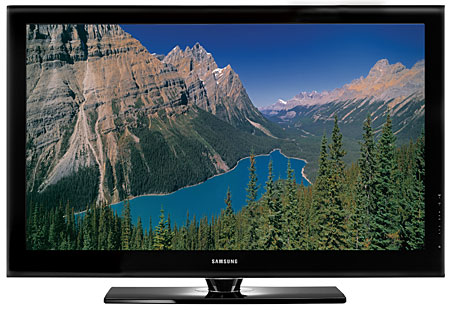Samsung PN50A550 Plasma TV

Think of it as the flat-panel equivalent of a Honda Accord. It's not the cheapest car on the lot, but it's not too expensive, either. Most important, you get a product that's beautifully built, sensibly equipped, and a pleasure to own and operate. Let's take one out for a spin, shall we?
Features
Samsung's 1080p plasma lineup for 2008 encompasses two levels or "Series." The top-of-the-line Series 6 includes a single model, the A650, with screen sizes of 50 and 58 inches. These sets feature Samsung's "Touch of Color" cabinet, which adds red highlights on the edges of a gloss-black bezel, as well as an upgraded chassis, screen surface, and remote.
Series 5 includes two models: the A530, which comes only in the 50-inch size, and two A550 TVs, with screens measuring 50 and 58 inches. The A530 is based on last year's design, whereas the A550 is pure 2008. The A550 and A650 both offer a WiseLink USB port, which lets you access and play JPEG photos and MP3 audio files saved on a flash drive or other USB storage device.
What do you give up with the A550 compared with the A650? For one thing, you don't get InfoLink, which displays weather, news, and business RSS feeds from USA Today if you connect the TV's Ethernet port to an Internet access point. Also, the A550's onboard audio system is a bit less powerful, it has one less HDMI input, and the cabinet does not have that Touch of Color. Only you can decide if these features—along with the upgraded chassis, screen surface, and remote mentioned above—are important enough to spend an extra $300 on the Series 6.
The A550's gloss-black cabinet is a cut or two above the norm. The bezel is a single molded piece with no visible seams other than a narrow opening that runs along the entire bottom edge of the bezel. When the set is on, a blue LED hidden inside the center of the speaker opening creates a softly glowing strip a few inches wide; this can be turned off if you find it distracting. The front-panel controls are located on the right side of the bezel face near the bottom, and the flush-mounted switches require only the lightest of taps to operate.
Samsung makes much of the set's FilterBright anti-glare screen, and it is indeed slightly less reflective than the screens on some other plasmas I've reviewed. Still, if your wife wants to leave the lamp next to your couch on so she can sew while you both watch The Daily Show (something that happens all the time in my house), the lamp's obvious reflection will cause mommy and daddy to have one of those events we euphemistically describe to the kids as a "discussion."
Image retention, or "burn-in," is a fact of life with any plasma display, and the Samsung provides several functions to help prevent burn-in or remove "after images" once they've occurred. Pixel Shift moves the image vertically, horizontally, or both by a user-definable number of pixels at a frequency you specify. According to the manual, a horizontal and vertical shift of two pixels every two minutes is optimal. If required, you can erase "stuck" images using the All White or Scrolling functions. Even without engaging these functions, I found that the Samsung was pretty resistant to image retention compared with previous-generation plasma TVs.
I was delighted to find that the bars used to fill the sides of the picture when 4:3 sources are displayed can be switched from gray to black. Burn-in or no burn-in, I absolutely loathe gray sidebars—being permanently stuck with them is deal breaker as far as I'm concerned.
The PN50A550 provides a 1:1 pixel-mapping mode, which Samsung calls "Just Scan." This important feature allows the set to properly display each and every one of the 1920x1080 pixels present in a 1080i or 1080p signal without introducing any picture-degrading overscan scaling.
The set's complement of HD-capable video inputs is generous, with three HDMI and two component inputs to choose from. However, there's only one good ol' composite-video input, and it's on the side panel. This location is fine for temporary connection of a camcorder or video-game console when the TV is stand mounted, but there really should be at least one other composite input on the back panel for permanent, wall-mount installations.
Finally, video geeks such as myself owe a tip of the propeller beanie to Samsung for including a blue-only mode. This nifty function eliminates the requirement to look through a blue filter when adjusting the color and tint controls using a SMPTE color-bars test pattern.
- Log in or register to post comments














































